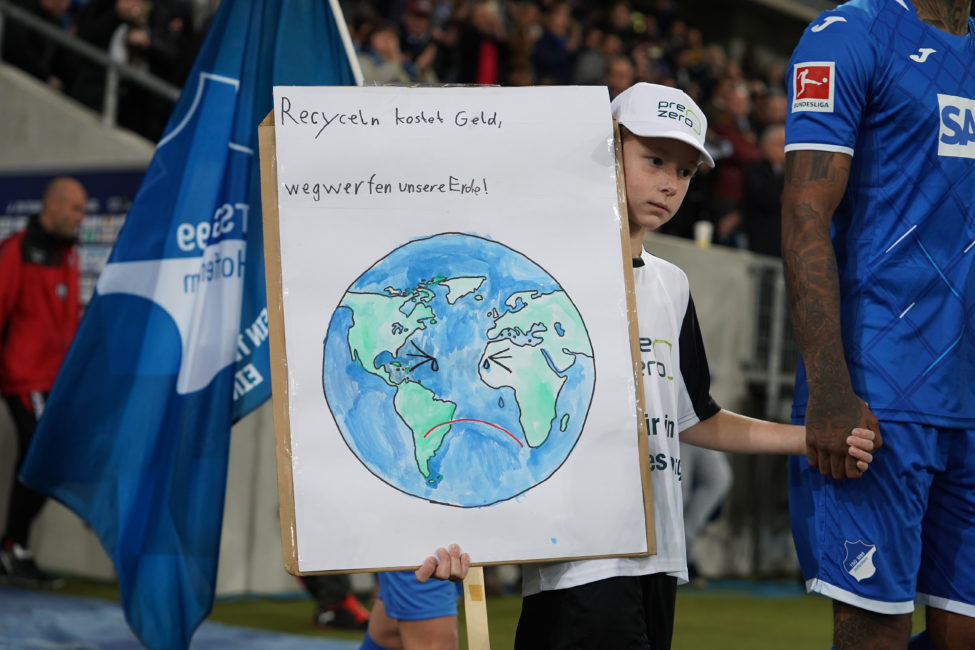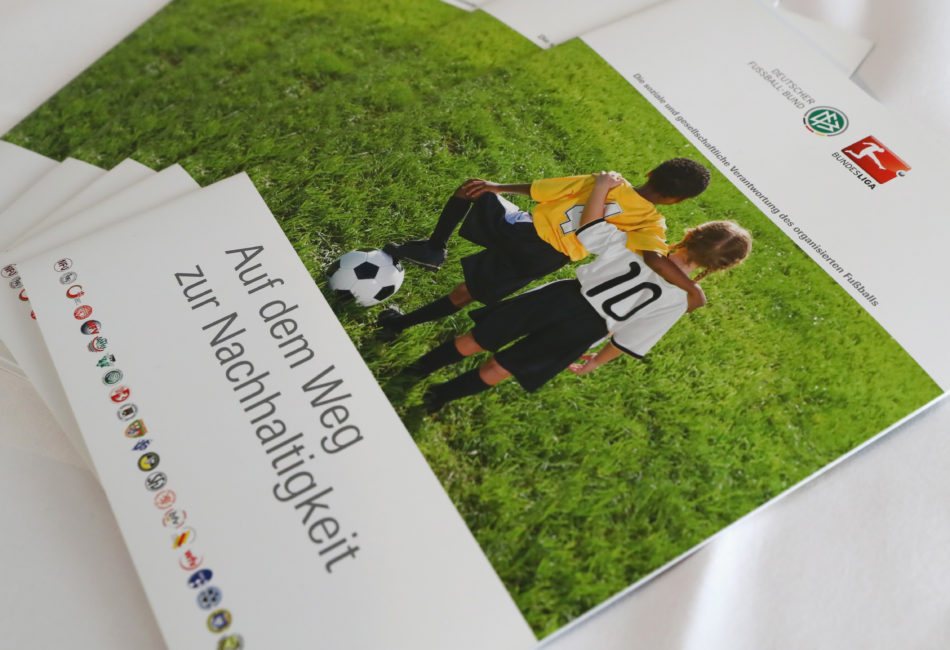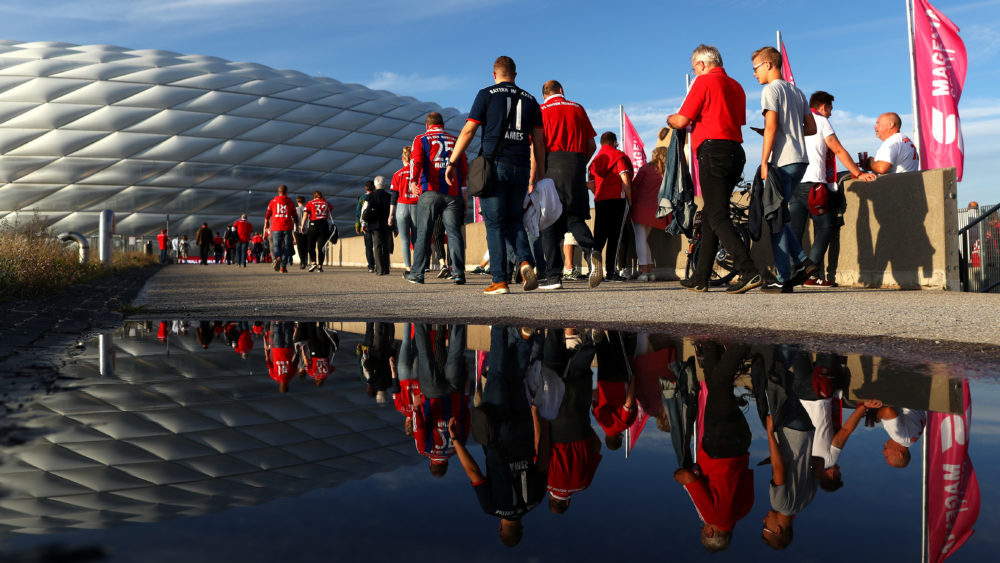Climate protection and German football – Part 1
The first part of the series takes a look at the eco-balance of German football using key figures and reports. In addition, Annika of the Fridays For Future (FFF) movement and climate expert Patrick Fortyr from the CO2OL agency present their demands for an ecologically sustainable football. Finally, there is also a look at the fans and their views on the issue.
Introduction
There is the one moment of germination of every article. For this article, it was a tweet from Max-Jacob Ost about an event that shortly afterwards became known in public as Basel-Gate. The short message contained an open question to the German Football Association: Why did the German national team fly the short distance from Freiburg to Basel to play their National League match against Switzerland on 6 September? The subtext was: Did anyone here think about the climate?
For me this Tweet was an awakening. For some time now, I have been committed to environmental sustainability in my private life. But the obvious connection to my great interest football I had never made before.
So the idea of writing an article about the environmental impact of football, the clubs in general and FC Bayern in particular, was born. I wanted to know how those involved see their own actions, whether they are aware of their responsibilities, what measures are already being taken and what is planned. With these questions in mind I started delving into my research.
A typical matchday in football in Germany
How far-reaching the issue of environmental sustainability in football is became clear to me only after I had begun to consciously reflect on the subject – but then it suddenly was all so obvious. Just look at the simple example of traveling to a stadium to attend a football match on a given matchday. Here, a variety of environmental issues arise along the entire timeline of the experience, from leaving home in the morning to travel to the stadium until the return back home late in the evening. Let us go through the process step by step.
The typical visit of a football match begins with the journey to the stadium. Teams, officials, journalists and fans make their way to the stadiums all over the country – by car, bus, train or plane. This begs the obvious question: How big is the travel-related ecological footprint of a match? How big is the footprint of an entire matchday?
Before they file into their seats, many fans make a stop at the fan shop. The selection of merchandise coming from all corners of the world ranges from the latest first team shirts to seasonal things like Christmas baubles. I wonder: What materials are used and how are these products produced?
The second stop before you reach your seat is often the food stand. With respect to catering, the food in the top leagues in many places is still almost identical to what you would be served in Sunday league. For the most part, it is all about the classic German bratwurst. I ask myself: What about vegetarian and vegan alternatives that have a better CO2 footprint?
Once you are seated and let your gaze sweep around the ground, all the neon signs and billboards make you wonder: Does the stadium actually use green energy and does it perhaps even have its own solar energy system? And what about the club’s other buildings – the offices, the youth academy and the training facilities?
These are all questions that one probably does not think much about in the exhilaration of victory, but with a view to our planet they are very pertinent nonetheless.
The environmental backpack
So what about football’s environmental sustainability in practice? How much CO2 does professional football emit? The Intergovernmental Panel on Climate Change recommended an annual consumption of no more than two tonnes of CO2 per head as early as 2011 in order to avert the threatening climate catastrophe. But just by attending a football match, a large part of that budget can be used up already.
Let us go through our matchday journey again – this time attaching concrete figures to it: For every professional football match in Germany, two teams, their coaches and officials, as well as, depending on the match, twenty to eighty thousand spectators travel to the match. Nowadays, going by plane has become the primary means of transportation for many away clubs. Only this way it seems possible for the players to regenerate appropriately in the heavily packed calendar full of fixtures in league, domestic cup competition(s), and Europe. Liverpool FC, for example, covers about 100,000 kilometres per season by plane. According to one climate researcher, this alone leads to CO2 emissions of 50 tonnes, which corresponds to the average annual emission of four to five people.
As if that were not yet bad enough, many clubs on away matches also send the team bus to pick up the team on the tarmac and drive them to their hotel and back and forth between hotel and stadium. By the way, the typical 50 seater bus makes the trip to the airport empty, the same as the return trip.
However, at least as much of the overall CO2 emissions football produces is due to the fans. In a study on their CO2 balance, VfL Wolfsburg estimates that fan mobility accounts for 60 percent of total emissions. Although most fans probably do not take the plane, they travel by car in their thousands. As the climate protection experts at CO2OL calculated, up to 70 percent of the fans travelling to Wolfsburg do so. For an FC Bayern fan who attends all away games, this means 17,558 kilometres of travel by car over the course of a season, corresponding to CO2 emissions of at least 3.56 tonnes.
The climate protection consultancy CO2OL has made further model-based calculations drawing on publicly available data. The CO2 footprint of a football fan per match day through the consumption of beer and bratwurst, including the waste produced, amounts to 0.3 tonnes of CO2. Extrapolated to a total matchday, 120 tons of CO2 are emitted throughout Germany through the provision of food inside the stadiums alone.
If these factors are added together, the model calculated by CO2OL shows that fan-related CO2 emissions for a single matchday amount to approximately 7,500 tonnes. This corresponds to the annual amount of emissions of a village with 700 inhabitants. For a season with 34 matchdays, an area the size of 48 football pitches would have to be planted with almost 60,000 trees to compensate for this amount of climate pollution. In addition, Germany’s stadiums use 30 million litres of water per year, which is roughly equivalent to the annual water consumption of 640 citizens. And even a single turf heating system consumes as much heating oil per day as a single-family house consumes in a year.
A changing industry
One should think that such remarkable figures should cause the football clubs to act. But what is the reality? Three example projects in professional football show that indeed there are indications of a change.
The first example is about Mainz 05 and their partnership with an energy company and former shirt sponsor of the club. The second is a project conducted by TSG Hoffenheim. The third and final one involves Forest Green Rovers as the first football club in the world to be certified as climate neutral by the UN.
At Mainz, the energy company built up an intensive partnership with the club, which eventually made them rethink their approach to environmental issues. Mainz 05’s head of business operations, Jan Lehmann, summarised his club’s efforts in an interview with Deutsche Welle as follows: “We take steps throughout the club to avoid and minimise resource use and to compensate for it”. Together with advisors from an environmental think tank in Darmstadt, the stadium and the club’s office buildings were scrutinized for their environmental impact. The measures that were subsequently developed were implemented with a clearer focus on ecological sustainability. Together with the sponsor, various activities were carried out to inform, sensitize and encourage the stadium goers to rethink their habits. Actions included competitions for fans who had travelled to the stadium by public transport.

(Image: Thomas Niedermueller/Bongarts/Getty Images)
The title of first climate neutral football club that Mainz 05 claimed for itself should nevertheless be viewed critically. Environmental expert Daniel Bleher points out that the “claim ‘climate neutral’ is not legally protected”. The emissions continue to be generated at the club, of course, but they are compensated for by the investment in reforestation projects in Canada. Bleher’s recommendation is therefore to speak of “climate fair” instead of “climate neutral”.
Yet the trend towards compensation for environmental pollution is gaining ground. TSG Hoffenheim is now also offsetting their own CO2 emissions and that produced by the journey of the away team and the referee team by supporting a reforestation project in Uganda. In addition, the club has defined five areas where they intend to link their own efforts to greater social benefits, as Stefan Wagner, Head of Corporate Development at TSG, explained in an interview with Kicker. Here, too, the club benefits from the cooperation with a sponsor, in this case a waste disposal company. Together, the club and the sponsor have carried out awareness programs at home games, but the company also actively participates in the disposal of waste in the Sinsheim Arena, Hoffenheim’s Home ground.
But other clubs have environmental sustainability and protection on their radar, too, and are trying to do their bit: There is a solar energy system at the Weser Stadium in Bremen, a club-owned well in Wolfsburg or veggie snacks at Borussia Dortmund. Only recently, 1. FC Köln announced that they wanted to have their sustainability goals checked by TÜV Rheinland, a private product certification provider. To this end, Köln plan to forgo air travel of the men’s team in particular in the future.
The international front-runner on environmental protection, however, is without question the English fourth division club Forest Green Rovers, who have even been classified as a climate-neutral football club by the UN. With using electricity made from solar and wind power, offering vegan food for players and spectators, and using organic fertiliser in the stadium, club owner Dale Vince has convinced fans and players with his concept.
The view of the fans
Alas, this commitment has seemingly not yet reached the fans. 79 percent of them stated in a (non-representative) survey conducted by Kicker that football lacks commitment to environmental protection
This is probably also due to the fact that still no Bundesliga player has made a public commitment to environmental protection. “There are many in the social sector who do this through a foundation, but I would not know of any environmental ambassador who is an active or former professional,” says climate expert Daniel Bleher on Deutschlandfunk radio. Patrick Fortyr of the climate protection consultancy CO2OL also says in an interview with me that professionals do not yet play a visible role in environmental protection and would have to use their influence much more to become effective role models for environmental protection.
And how do the fans themselves see it? Are they aware of their importance when it comes to environmental protection? An interview with Alexander Fischer from Club No. 12, an association of organised fans of FC Bayern, presents a different picture. According to him, the topic of ecological sustainability is “not a big issue among the fans in the stands at the moment.” He justifies this by prioritising other topics, but also by the behaviour of the typical supporter. They “usually supply themselves with food before a game” and travel by bus or train wherever possible. Yet concrete actions of the organized fans or the inclusion of environmental sustainability as a dedicated working area for Club No. 12 are “not currently planned.”
Requirements for a sustainable football
The lack of response from fans shows that the actions of the Bundesliga clubs do not yet go far enough. This is what Annika from Fridays for Future and Patrick Fortyr from the agency CO2OL said to me in an interview.
The FFF movement sees football as a “mass sport that is an integral part of our culture and should set an example and communicate our common values accordingly”. But the duty would not end there. Annika, who has been working for FFF in Hamburg since 2019, makes it clear that “the sport itself has to become climate neutral by 2035. This includes, for example, reducing flights, switching to renewable energy to power stadiums, and selecting sponsors based on eco-sensitive criteria”. Her colleague Vincent echoes her views, stating in a football TV show that he would also like to see vegetarian alternatives to the common stadium sausages, the clubs printing their CO2 balances in their stadium booklets for everyone to know, and that they make the switch to mobile phone tickets.
The activist sees this a responsibility of all sides: The football associations, who should hold the clubs to account; the clubs, who should take more care in choosing their sponsors; the players, who should use their profile and visibility to educate the public; and the fans, who should demand action from the clubs.
Patrick Fortyr also sees environmental protection as a project that must be fought on several fronts: “Climate protection is a task for the society as a whole.” Moreover, clubs should publish a corporate carbon footprint or a life cycle assessment that evaluates the overall ecological impact of their business and thus goes beyond the mere climate aspect, or be required to do so by the lawmaker or licensing association. Non-binding guidelines, such as the DFB’s catalogue of ideas on environmental protection, are of little value to him because they are “no more than a drop in the ocean”.

(Image: Martin Rose/Bongarts/Getty Images)
In addition, clubs would have to work on implementing climate-neutral business operations and set science-based reduction targets for themselves. Fortyr sees the role model function as a central aspect: “The clubs must, of course, also be authentic role models. But this lever is used almost exclusively for advertising (sponsors). Why don’t we use this lever much more to trigger a change in thinking among fans and in society?” To raise awareness among fans, incentive systems for climate-friendly behaviour could help. Fortyr recommends that fans walk to the stadium or use public transport, that they do without the stadium sausage, and that they reconsider whether it really has to be the latest edition of the first team shirt every year.
Their demands do not fall on deaf ears in professional football. Former DFL Managing Director Andreas Rettig called on the DFL to include ecological aspects in the licensing of the clubs. And the Green politician Anton Hofreiter criticised the lack of clear rules for environmental and climate protection.
Annika from Fridays for Future summarises: “Climate protection really does necessitate a change in all sectors. However, such a rethink needs a fresh jolt from time to time.” As TSG Hoffenheim’s main backer Dietmar Hopp told Kicker: “Outside pressure to wake up professional football is great. But it would also be important for a major player like FC Bayern Munich or Borussia Dortmund to actively embrace such issues in order to achieve the greatest possible effect”.
In part two, the focus is on FC Bayern. In an interview with a representative of FC Bayern and with Jürgen Muth, the managing director of the Allianz Arena GmbH, I talk about the record champion’s plans.





